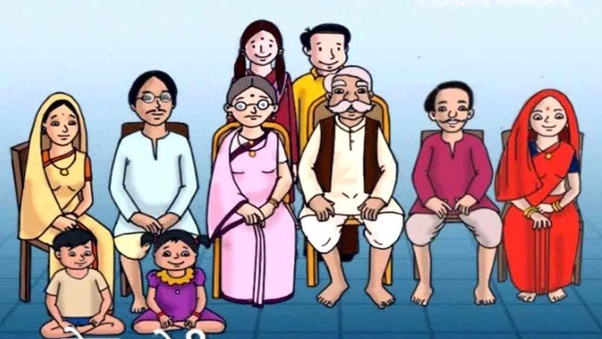This article is written by Heba Ali, a 2nd year B.B.A. LL.B Student at Symbiosis Law School, NOIDA. This article talks about Devolution of Interest relating to Mitakshara Family in detail, along with the cases decided in the past.
Introduction And Evolution
The evolution started from a joint family which is an extended family group formed by persons who are lineally descended from a common ancestor, their wives and their unmarried daughters and on their marriage, daughters get inducted into their husband’s joint families. There may be families where a joint family may not be living together and the family may not have or share a common property. But the binding thing is not co-living or property but the relationship by consanguinity, affinity or adoption. The Mitakshara school of Hindu law has its own concept of joint family based on the doctrine of right by birth which means janmswatavada.
The main unit is coparcenary which basically consists of a man and the male descendants of the next three generations in the direct line of descent. Here, all the male in each of the next three generations irrespective of their numbers are the coparceners. The coparcenary unit is nothing but an outgoing unit and it changes time to time with the changes in the family. And on the death of the common ancestor fifth-generation steps into it.
Non-coparcener member of a joint family includes coparcener’s wives or widows, daughters until their marriage and even descendants of any degree below the fourth generation at any given pint of time. They do have rights of subsistence in the joint family but they are not co-owners with the coparceners.
One more basic mitakshara doctrine is that once a joint family comes into existence then it remains generation after generation. It is not important to have the presence of a common ancestor or more. It may happen that a single coparcener may be the sole surviving coparcener and he may continue the joint family with its non-coparcener members also.
There is also one thing which has a great significance is that since Hindu law equates adoption with birth so children who are adopted in the family also become its part as coparceners or non-coparceners as the case would be. Here in case of mitakshara family, all properties are inherited from the ancestral who are male ancestors and then it becomes the joint property of the family.
Their ownership remains with the coparcenary with no as such defined interest for any of its members and the principal is famously called as upramswatvavada. When there were no statutes which governed or covered mitakshara law of joint family as a whole than in such case judicial precedent has been and remained a major source. The Law reports of India has many judicial decisions which are both of pre-independence and post era.
Most of the cases lie under taxation laws of India which has a special provision under it for Hindu Undivided Family (HUF). In many cases decided over a period of time it has been held that a joint family may consist of a coparcener and his deceased brother’s widow or his wife and unmarried daughter, then it is not necessary for a joint family to have its own property and the law also does not require it to be and neither asks for the ownership on the part of any joint family, where a lease deed is recorded in the name of a member of the joint family but there is no evidence that the lease was granted to him in his individual capacity than in such cases after disruption of the joint family the leased land will belong to the joint family.
It is presumed that the existence of a joint family is getting weaker from descendants because of the separate possession of the property as held in the case of UR Viruprakashiah v Saarwamma. Then in case of management of the whole family a Karta must be a coparcener and a non-coparcener member of the joint family cannot in his own right would act as Karta but a junior member could act as Karta with everyone’s consent in the family as decided in Commissioner of Income Tax v Govindram Sugar Mills and in Radha Krishan Das v Kaluram.
Meaning
It is said that the joint family system is the survival of age when in the Ancient communities of Asia and Europe, the family was the primary unit. In those time the Hindu father was the absolute proprietor of the person and the property of the family but now with the changing times, he only represents the family. It was observed in the Indranarayan case it was presumed that joint and undivided family is a normal condition of the Hindu society.
Dayabhaga and Mitakshara—the two forms of customary caste- Hindu property holdings and marriage only between two Hindus. Mitakshara are the two faculties of law that govern the law of succession of the Hindu Undivided Family under Indian Law is getting weaker and weaker descendant after descendant because of the evidence of separate possession of property which is getting more prominent over the years especially the post-independence era and also because of other reasons and legislations which are explained below.
In the State of Kerala abolished the doctrine in 1975 under law abolishing the Mitakshara coparcenary in 1975. But different states legal guidelines which have been enacted within the year 1986-1994 in Andhra Pradesh, Tamil Nadu, Karnataka and Maharashtra did not amend the vintage doctrine of Mitakshara coparcenary that is one of the conventional laws.
Then in 2005 central amendment of the Hindu Succession 1956 Act has abolished the principle of pious obligation with effect from the date of its commencement which is 9 September 2005 and has laid down that after this no court is going to recognize the right of a creditor to seek judicial relief for realizing his debt only on the grounds of this doctrine of Mitakshara coparcenary. But it is not removed totally, the old principle remains applicable only to those debts which are incurred before 9 September 2005 and that too only against the descendants of those who are born before that date.
Under classical Mitakshara law a son, grandson and great-grandson have a type of ‘pious obligation’ to pay the unpaid vyavaharik which means incurred for a lawful purpose. It is debts of their father, grandfather or great grandparents as the circumstances of the case may be.
The obligation applies to them if they were joint when the debt was contracted but if they had separated earlier, they will not be bound by it. However, they cannot escape the liability by separating after the debt has been incurred. While in the meantime Supreme Court has explained this Mitakshara doctrine and its implication in a number of judgements pronounced in cases such as Pannalal v. Naraini, Sidheshwar v Bhubaneshwar, Faqir Chand v Harnam, Prasad v Mudaliar and many more like this.
In a revolutionary change brought from 1986 onwards as laws were enacted in four different states in India to confer the status of coparceners on daughters on a par with sons and it was beyond the scope of the 1956 Act. And because of this, all the four states introduced it by inserting a new additional provision into the Hindu Succession Act 1956.
The first state which undertook this radical reform was the state of Andhra Pradesh which amended the Hindu Succession Act in 1986 to grant coparcener’s status on daughters on a par with the sons. And for doing so the Hindu Succession (Andhra Pradesh Amendment) Act 1986 was into the Act with three new sections and were enforced from 5 September 1985.
Then three years after the reform took place in Andhra Pradesh, the state legislature of Tamil Nadu also enacted the Hindu Succession Act 1988 which is Tamil Nadu’s Amendment to insert the same three new section 29A, 29B and 29C written down into the Hindu Succession Act 1956 in its application to the State with effect from 25 March 1989.
The third state to incorporate the new Sections- 29A, 29B and 29C into the Hindu Succession Act 1956 was Maharashtra in western India which came into being in the year 1994 and was enforced from 22 June 1994. But, the fourth state of Karnataka did not add it into a new Chapter but as section 6A, 6B and 6C after section 6 of the central act.
This, in my opinion, was rather more systematic but the assent which was required from the president of India was delayed and so it came into force only after four years on July 30 1994. This way all the four states introduced reforms which were very significant in the Mitakshara law of joint family. Till now all of them remain in force and have not been repealed either by the state or by the central act (Hindu Succession Act) of 2005.
The Changes Which Led to The Devolution of Interest in Mitakshara Family
The presumption is that there is a devolution of interest in Mitakshara Family because the joint family system (Hindu Undivided Family) is getting weaker and weaker from descendant to descendant and this can be rebutted to the evidence of separate possession of the property. Also, this so because its continuance has been greatly curtailed down by Hindu Succession Act 1956.
Some of the reasons which could be given are the bill for the succession law which was specifically made to exclude Mitakshara joint families to come under the ambit of the new law. Like, the undivided share of a deceased coparcener is to be governed by the Act and was to be ascertained on the basis of a presumed claim of partition on the part of the deceased on his death.
Coparceners who are separated from the coparcenary before its commencement are to be kept outside the scope of this part. Then the heirs who would attract the application of this part included mother, wife, daughter and others as specified in the 1956 Act.
The act of 1956 also declared that the shares of coparceners which are undivided in a Mitakshara joint family would be their bequeathable property. And because of the provisions of the 1956 Act which had led joint families to the law of inheritance in certain cases had led to the law of wills in all of them and had eventually narrowed down the scope for the continuation of Mitakshara joint families to a large extent.
But till now it is in existence because mitakshara joint families are a great attraction for tax savers and taxation laws call them as Hindu Undivided Family. So, the HUFs enjoy all the deductions and exemptions while paying tax under the Income Tax Act.
Revolutionary Changes Made After Independence
The 1976 Kerala State legislature enacted the Kerala Joint Hindu Family (Abolition) Act 1975 to abolish wholly the doctrine of the right to property by birth. All Mitakshara coparcenary which was present at the time were converted by this law into tenancy-in-common in which shares are held in common presuming that a partition had taken place between all the coparceners but they were holding it as their respective shares separately as their full owners.
The Act passed by the legislature also had an implication of amending section 6 of the Hindu Succession Act 1956, that is while applying it in each and every case the shares of individual joint family members would be governed by the laws of the act.
Before the commencement of the (Hindu Succession Act) HSA, codifying the policies of succession, the idea of a Hindu family under Mitakshara law become that it was joint not only in estate however in spiritual subjects also. Coparcenary assets, in contradiction with the absolute or separate assets of an individual coparcener, devolve upon surviving coparceners within the family, in line with the rule of devolution by way of survivorship.
One of the predominant adjustments delivered in by means of the amendment is that during a Hindu joint family, the different prerogative of males to be coparceners has been changed altogether and the proper by means of delivery inside the coparcenary assets has been conferred in favour of a daughter as well. This radical trade has essentially altered the person of a Mitakshara coparcenary.
Before this relevant enactment, four Indian states had delivered in a similar trade, the introduction of daughters as coparceners. A gift, in place of best, the son having a right through birth, any baby born inside the own family or validly adopted can be a coparcener and could have a hobby over the coparcenary assets. Thus, the traditional concept that only males might be members of the coparcenary and no girl may want to ever be a coparcener nor may want to personal coparcenary assets is not the law.
Nowadays or one can say in modern condition of society has weakened the presumption that jointness is stronger in case of near relations like father, sons and the remote it gets so weak it goes. Thus, the chord that used to bind the members of a family is not property but the relationship. One thing which is important to remember is that Hindu family is not a juristic person and so it cannot hold the property of its members independently.
Changes in the Authority Structure
Due to the decline of the joint family system nowadays there have been changes in the authority of the family as we can look back in the days when the authority of the family was primarily in the hands of family elders who were commonly known as Karta in Hindi. The general attitude of the members of the family towards the traditional patriarchy was mostly one of the respects and is present now also.
And loyalty, submissiveness, respect and deference over the household were on their shoulders. These attributes had even surpassed other relationships in the family; for example, such as children to their parents, a wife to her husband and younger brothers to their older brothers. And especially within a household, no one was supposed to flout the will of his elders.
The fathers, or in his absence the elder brother was consulted on all important family matters like pursuing litigation in the courts of law, building a house or even in cases of the arrangements of marriages. Also, the joint family did not allow elders being neglected or for that matter any kind of disregard of elders. The age-grade hierarchy was quite strong but now the people of younger generation and particularly those people who are equipped with modern type of education do not seem to show the same reverence with their fathers (or parents) had for their parents or even the elders in the family.
But the authority or the position of women differ and was totally depended on the positions of their husbands in the family or in the household. And the wife or spouse of the head of the family or even the mother-in-law was in charge of the household. And her words were law or had at least had the same or given the same importance.
This thing is even prevalent even nowadays in many families not just in small towns but the big cities too. And the decision made by her were for the entire family and its members and not for the good of the individuals residing in it. The young women in the family were expected to be obedient and had to abide by the rules.
Self-assertion was required even in bringing up their own children was considered, as blasphemy. Widows and those who were rejected by their husbands were given assurance of the family roof but they mostly had no voice of their own in the family.
And with the aim of resolving such issues of themselves and responsibilities; parents very cunningly encourage their educated sons and daughter-in-law to take independent decisions in joint or even in the extended families. This is now not only the case in urban areas but in rural areas too. This type of case is not unusual when sons and daughters possess a high level of education and a greater degree of exposure of the world outside the family than ever before.
In today’s date whether it is man or woman or a boy or girl and this one is contrary to the old practice, they are beginning to assert their wishes in the mate selection. Also, the parental decisions are no more considered as supreme as was the case back in the earlier days. But the changes concerning erosion of the authority of old guards particularly while taking decisions of marriages are on a gradual decline in rural areas too.
But an interesting fact was discovered about the change in authority structure within the family is that about nine to ten percent of the households are headed by women (female members) while the National Family Health Survey-1 (1995:46) gives a slightly different picture which is slightly higher in figure (up to 10 percent). It shows that most of the household heads are usually independent and gainfully employed. In the absence of their husbands which could be either because of their deaths, separation, transfer in jobs or business engagements or maybe because of other reasons women are themselves able to run the affairs of the family.
Especially because of the migration of men to much longer distances for employment is also one of the important reasons for the emergence of such households. The phenomenon of female-headed household assumes significance in the Indian society because in the past when the joint family system was much prevalent then that female-headed household was not that quite prevalent or was an uncommon phenomenon.
Reforms
The concluding remarks would be that because of the rise in the number of single-member households, break-down of traditional joint family system and increase in the number of divorce cases and especially individual males migrating to the big cities for better work and living standards there has been erosion of authority of patriarch, then erosion of family values and increase in the number of working mothers in cities and especially more single parents.
Then rise in domestic violence and more practice of dowry, children and elders being neglected and disregard to laws made for the preservation of family system are enough indications that show the danger that the family and in the end society are what progressively facing in a country like India.
To combat this situation which is continuous erosion of culture and values attached to it there needs to be a set of strong, consistent policies to strengthen the Indian family system. Otherwise, India would be left with no choice but they will be facing the same problems as being faced by many families around the globe in many of the developed countries. And to tackle this situation there need to be more specific reforms which will help us to transform like increased support in the areas of childcare, social services, income assistance and other health services than it was ever there before.
In fact, in view of problems of various kinds which is being faced in the past as well as now and possible challenges of future there is a need of Family Policy Council in each state of India to conduct policy analysis, promote intergenerational solidarity, facilitate strategic leadership involvement and influence public opinion and this method has been adopted by many countries abroad to tackle the difficult situations.
Conclusion
The following are the points because of which there has been devolution of interest relating to mitakshara law which is descendant after descendant because of the evidence of separate possession of the property. When a coparcener dies, his undivided interest in the joint family property devolves by the members who are surviving. But it does not devolve by succession to his heirs said in one of the cases.
And when there is a separate property of an intestate coparcener and on his death, Hebait passes by succession to his heirs but not by survivorship to the surviving coparcener. As it is seen today, that the principles of Hindu regulation constitute an anomaly unheard of inside the history of the sector. Law, no much less than lifestyles, should obey the ideas of alternate to be able to be important and to conform itself to altered social situations. It is a truism that vintage dogmas melt in new currents of notion. Law ought to always be dynamic, no longer static, if it’s miles to be assimilated to the force of milieu.
The antique race of commentators who via interpretation, annotation, and analogy brought the Hindu regulation in line with altered social situations, is extinct and their career is gone. The scanty wealth comprising some pots and pans, some livestock, and a bit grain which became all that the Aryan householder became commanded to possess and for the disposal of which a few tough and ready felony regulations had been laid down, is a hanging anachronism in in recent times of growing industrialization and the sizable accumulation of wealth.
Further, justification of the chronic exclusion of ladies from property on the premise of the want to safeguard them from instances of domestic violence amounts to a grant of an exemption to the State from due overall performance of its maximum fundamental duty. Moreover, this argument presumes the non-formation of suitable norms in society subsequent to a due exchange in the law which can efficaciously exchange behavioural tendencies. On a concluding note, therefore, it may be stated that although the HSA became a tremendous measure, it did not efficaciously avail of the opportunity to actually empower the ladies of India.
 Serato DJ Crack 2025Serato DJ PRO Crack
Serato DJ Crack 2025Serato DJ PRO Crack











 Allow notifications
Allow notifications



